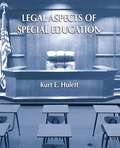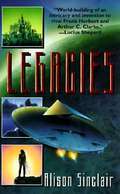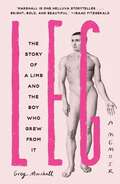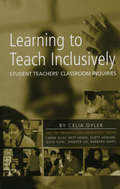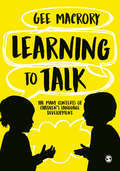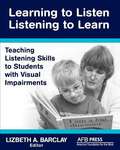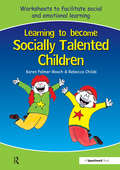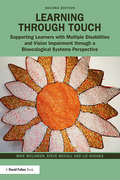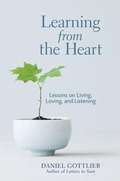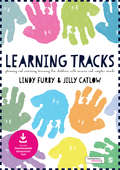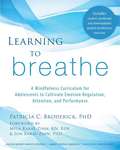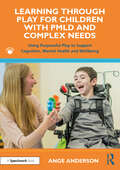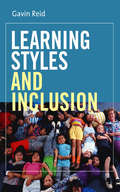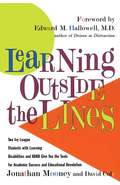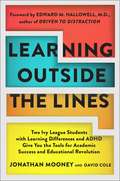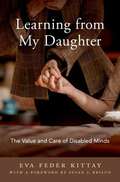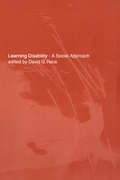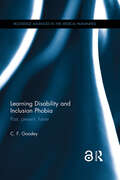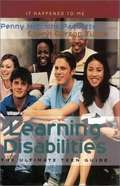- Table View
- List View
Legal Aspects Of Special Education
by Kurt E. HulettFor every course in Special Education Law and Education Law, or as a perfect supplement to any Educational Administration course, Legal Aspects of Special Education was written by a practitioner to help teachers, administrators, and advocates understand special education law in everyday language- without excessive legalese or extraneous case law. Different in many ways from other special education law texts on the market, all of the elements of this text are intended to help its students obtain the most critical information about special education law and how it is applied in the real world. Some unique features include: a fascinating opening interview and then epilogue with Joe Ballard, a pioneer of the IDEA movement; a discussion of Response-to-Intervention (RTI) and the implication of IDEA 2004 for school districts; and a discussion of the history of special education and its link to the Civil Rights Movement. Additionally, the book provides case studies and application questions, critical thinking questions, the most current information on the laws including No Child Left Behind and the Individuals with Disabilities Education Act of 2004, and a discussion of major trends changing the laws, including that of autism.
Legacies
by Alison SinclairFive generations ago a renegade band of star voyagers fled their home planet. Looking back, they saw a terrible sight--their world twisted, misshaped, destroyed by the incalculable blast of their untried star drive, fired too close to home. Doomed to wander the universe, the planet killers found refuge on a dark planet circling a dim star. Now it's time for the Returning--time to enter the hole they ripped in creation and find the world they lost.
Leg: The Story of a Limb and the Boy Who Grew from It
by Greg Marshall* A MOST-ANTICIPATED SUMMER READ SELECTED BY * Washington Post *Buzzfeed * Bustle * The Advocate * LitHub * Bookriot * Electric Literature * and more!*A hilarious and poignant memoir grappling with family, disability, and coming of age in two closets-as a gay man and as a man living with cerebral palsy'Leg is intimate (and I mean that in all ways), insightful, and often laugh-out-loud funny.' - SCOTT SIMON, NPR'One hell of an entertaining book.' - BUZZFEED, Most Anticipated LGBTQ+ Books of 2023'Greg Marshall is one helluva storyteller . . . bright, bold, and beauitful.' -ISAAC FITZGERALD'A strange, smutty, hilarious, beautiful, compassionate, provoking, big-hearted, sharp-tongued, original, brilliant memoir. I hated to see it end.' - ELIZABETH McCRACKENGreg Marshall's early years were pretty bizarre. Rewind the VHS tapes (this is the nineties) and you'll see a lopsided teenager limping across a high school stage, or in a wheelchair after leg surgeries, pondering why he's crushing on half of the Utah Jazz. Add to this home video footage a mom clacking away at her newspaper column between chemos, a dad with ALS, and a cast of foulmouthed siblings. Fast forward the tape and you'll find Marshall happily settled into his life as a gay man only to discover he's been living in another closet his whole life: he has cerebral palsy. Here, in the hot mess of it all, lies Greg Marshall's wellspring of wit and wisdom.Leg is an extraordinarily funny and insightful memoir from a daring new voice. Packed with outrageous stories of a singular childhood, it is also a unique examination of what it means to transform when there are parts of yourself you can't change, a moving portrait of a family in crisis, and a tale of resilience of spirit. In Marshall's deft hands, we see a story both personal and universal-of being young and wanting the world, even when the world doesn't feel like yours to want.
Left for Dead
by Jon Hovde Maureen AndersonA book written by a Vietnam Veteran describing his war experiences, the loss of his arm and leg, his struggles because of those injuries, and the aftermath of his war experiences and subsequent injuries.
Learning to Teach Inclusively: Student Teachers' Classroom Inquiries
by Celia OylerThis book—co-authored by a teacher educator, a diverse group of five pre-service student teachers, and their student teaching supervisor—takes a unique, illuminating look at the experience of student teaching from the perspective of student teachers. It is premised on learning to teach as an inquiry process enriched by collaborative conversations. Readers are invited into student teachers’ dilemmas and decisions as they negotiate between their public school placements and their university-based coursework. Throughout the year of student teaching, the authors document their discussions and reflections about teaching in inclusive classrooms that shed light on the complex process of learning to teach and also offer insights into issues of teaching for equity. Each of the central chapters is written by an individual student teacher and tracks a specific question over the course of two semesters. Topics include: *contrasting models of inclusion and teachers’ differing orientations toward issues of community, difference, and normalcy;*how teachers foster peer relationships;*classroom management and discipline; *heterogeneous instruction; and*school-wide culture and systems that promote or mitigate against inclusion. A new perspective on what can be learned from student teaching is provided by the student teachers’ supervisor. In the concluding chapter, the teacher educators address the connections among the student teachers’ inquiries and offer an analysis from a disability studies/disability rights perspective on how inclusion fits into a social (rather than a medical) model of disability. All of the authors of this book seek to contribute to conversations that place advocacy, inquiry, contestation, and challenge at the center of the teacher’s role. This volume is their invitation to readers to join in a larger conversation about the challenges of, and necessity for, becoming inclusive teachers. Learning to Teach Inclusively is intended for inservice and preservice courses in elementary education, inclusion, and teacher research, and for field experience seminars. It is also suitable for graduate courses in teacher research, supervision, and research in teacher education.
Learning to Talk: The many contexts of children’s language development
by Gee MacroryThere is a pressing need for new teachers to understand the wider context of language development and to know how best to support children in learning to talk. This accessible text introduces you to the numerous contexts of language development. It helps you understand the many ways in which children acquire language skills. Importantly, it provides a breadth of learning about language not offered by other texts exploring typical language development, atypical language development and learning more than one language. The book also explores the current literature and research on language development for primary aged children, supporting trainee teachers with their academic study.
Learning to Talk: The many contexts of children’s language development
by Gee MacroryThere is a pressing need for new teachers to understand the wider context of language development and to know how best to support children in learning to talk. This accessible text introduces you to the numerous contexts of language development. It helps you understand the many ways in which children acquire language skills. Importantly, it provides a breadth of learning about language not offered by other texts exploring typical language development, atypical language development and learning more than one language. The book also explores the current literature and research on language development for primary aged children, supporting trainee teachers with their academic study.
Learning to Listen/Listening to Learn
by Lizbeth A. BarclayLearning to Listen/Listening to Learn is the first comprehensive work to address the systematic development of skills in listening for and interpreting auditory information for students who are blind or visually impaired. Listening skills are a crucial but often-overlooked area of instruction for children who are visually impaired and may have multiple disabilities, essential to literacy, independent travel, and sensory and cognitive development. Chock full of practical strategies, this volume examines the development of and instruction in learning skills at different ages, from infancy through high school. It also addresses listening skills in orientation and mobility and the needs of children with multiple disabilities, hearing impairment, and learning disabilities, as well as English language learners. Appendixes provide a Listening Skills Continuum chart and a checklist to use in assessment.
Learning to Become Socially Talented Children
by Karen Palmer-Roach Rebecca ChildsThis resource includes more than 70 worksheets to make social and emotional learning fun! This resource uses exciting graphics, games and activities to engage and stimulate children in the learning process. It deals with a wide range of issues that affect children today.
Learning through Touch: Supporting Learners with Multiple Disabilities and Vision Impairment through a Bioecological Systems Perspective
by Mike Mclinden Steve Mccall Liz HodgesThis fully revised and updated second edition of Learning through Touch is essential reading for practitioners who support learners with multiple disabilities and vision impairment. These learners will rely on support from their learning partners throughout their education to mediate their learning experiences. The text explores the key role that touch plays in the education of these learners and provides practical advice about how to develop the skills through touch that they will need to become ‘active agents’ in their own development. The book reflects international initiatives that seek to ensure that people with disabilities have opportunities to take meaningful control within their learning and their lives. Key features include: Chapters that support curriculum access for learners with visual impairments; Reflections on up-to-date research studies and guidance for further reading throughout, allowing for a strong conceptual foundation for practice; Portfolio activities designed to help implement effective learning opportunities within your own practice. Written to assist teachers and other professionals who support children with visual impairment and additional difficulties, this text will appeal to professionals and students alike. It is an invaluable resource for anyone looking to explore the role of touch in creating effective learning experiences.
Learning from the Heart: Lessons on Living, Loving, and Listening
by Daniel GottliebIn the nearly 30 years since the accident that made radio personality and columnist Dan Gottlieb a quadriplegic, he developed a finely-tuned quality of awareness that most people never achieve: he became an outsider among us--"like a foreign correspondent," as he puts it. From that vantage point, he has acutely observed the way people act, think, feel, and live--in short, he studied and learned exactly what it means to be human. Here, Dan shares his insights, written with humor, honesty, a gift for storytelling, and breathtaking compassion. Learning from the Heart looks at what divides as well as unites us, including the problems of family life; difficulties confronting today's parents; challenges faced by the disabled and the aging; and issues of injustice that affect the way we understand the world and our lives. Although Dan is now speaking directly to the reader, rather than to his own family, you'll recognize the distinctive voice and format that caused an outpouring of e-mail from fans of Letters to Sam: short anecdotal chapters rich in wisdom, generously revealing and deeply personal, and resonating with universal truths.
Learning Tracks: Planning and Assessing Learning for Children with Severe and Complex Needs
by Jilly Catlow Lindy FurbyLearning Tracks is an assessment tool to support the planning and assessment of learning for children and young people with severe and complex learning disabilities (SCLD). It was designed by Lindy Furby and Jilly Catlow while teaching at St Crispin’s School for children and young people with severe and complex learning disabilities. At the very early stages of learning, the steps that children and young people make can be small but incredibly significant for them and those who teach them. However, it can be problematic to evidence and formally recognise these achievements and plan next steps. Learning Tracks presents a framework to recognise achievement at these early levels and plan for progression through challenge, breadth and application. The Learning Tracks framework for recognising achievement at very early levels of learning: Can help teachers understand the way their children may be learning Offers a vocabulary for describing the learning Offers a structure for planning the learning When you purchase Learning Tracks, you receive the book that introduces you to the framework and theories underpinning Learning Tracks, describes the curriculum included and demonstrates how it can be implemented in your setting. In addition to this book you will also receive access to the complete ready-made Learning Tracks assessment tool that can be downloaded online. This is available as a PDF with editable elements and a template you can personalise it to suit your individual needs.
Learning Tracks: Planning and Assessing Learning for Children with Severe and Complex Needs
by Jilly Catlow Lindy FurbyLearning Tracks is an assessment tool to support the planning and assessment of learning for children and young people with severe and complex learning disabilities (SCLD). It was designed by Lindy Furby and Jilly Catlow while teaching at St Crispin’s School for children and young people with severe and complex learning disabilities. At the very early stages of learning, the steps that children and young people make can be small but incredibly significant for them and those who teach them. However, it can be problematic to evidence and formally recognise these achievements and plan next steps. Learning Tracks presents a framework to recognise achievement at these early levels and plan for progression through challenge, breadth and application. The Learning Tracks framework for recognising achievement at very early levels of learning: Can help teachers understand the way their children may be learning Offers a vocabulary for describing the learning Offers a structure for planning the learning When you purchase Learning Tracks, you receive the book that introduces you to the framework and theories underpinning Learning Tracks, describes the curriculum included and demonstrates how it can be implemented in your setting. In addition to this book you will also receive access to the complete ready-made Learning Tracks assessment tool that can be downloaded online. This is available as a PDF with editable elements and a template you can personalise it to suit your individual needs.
Learning To Breathe: A Mindfulness Curriculum For Adolescents To Cultivate Emotion Regulation, Attention, And Performance
by Jon Kabat-Zinn Myla Kabat-Zinn Patricia BroderickDisruptive behavior in the classroom, poor academic performance, out-of-control emotions: if you work with adolescents, you are well-aware of the challenges this age group presents. What if there was a way to calm these students down and arm them with the mindfulness skills needed to really excel in school and life? <p><p> Written by mindfulness expert and licensed clinical psychologist Patricia C. Broderick, Learning to Breathe is a secular program that tailors the teaching of mindfulness to the developmental needs of adolescents to help them understand their thoughts and feelings and manage distressing emotions. Students will be empowered by learning important mindfulness meditation skills that help them improve emotion regulation, reduce stress, improve overall performance, and, perhaps most importantly, develop their attention. The book also includes a website link with student handouts and homework assignments, making it an ideal classroom tool. <p> The book integrates certain themes of mindfulness-based stress reduction (MBSR), developed by Jon Kabat-Zinn, into a program that is shorter, more accessible to students, and compatible with school curricula. Students will learn to pay attention in the moment, manage emotions as they are perceived, and gain greater control over their own feelings and actions. These mindfulness practices offer the opportunity to develop hardiness in the face of uncomfortable feelings that otherwise might provoke a response that could be harmful (e.g. acting out by taking drugs, displaying violent behavior or acting in by becoming more depressed). <p> This easy-to-use manual is designed to be used by teachers, but can also be used by any mental health provider teaching adolescents emotion regulation, stress reduction and mindfulness skills. The author is a graduate of the MBSR advanced practicum at the Center for Mindfulness in Massachusetts, led by Jon Kabat-Zinn. She is also a clinical psychologist and a certified school psychologist and counselor for grades K-12. In the book, Broderick calls on her years of experience working with adolescents to outline the best strategies for dealing with disruption in the classroom and emotions that are out of hand. <p> The book is structured around six themes built upon the acronym BREATHE, and each theme has a core message. The program allows for themes to be delivered in 6 longer or 18 shorter sessions, depending upon time and needs of students. The 6 core lessons are: Body, Reflection, Emotions, Attention, Tenderness, and Healthy Mind Habits. <p> Learning to Breathe is the perfect tool for empowering students as they grapple with the psychological tasks of adolescence.
Learning Through Play for Children with PMLD and Complex Needs: Using Purposeful Play to Support Cognition, Mental Health and Wellbeing
by Ange AndersonThis book examines the development of play skills and schemas to support children with learning differences and physical disabilities in learning to play. It highlights the need for appropriate playground equipment in all school settings that educate children with physical disabilities and sensory needs to ensure equal opportunities for outdoor play. Several play approaches for meeting sensory needs are discussed including Lego therapy, Art therapy, Sand play and Soft play. Digital play for students with physical disabilities is an important chapter in the book. Role play and the ways in which virtual reality and psychodrama support anxieties that some students have is another important chapter. There is also a chapter devoted to parents on how they can support their child at home and how the school can support them. At the end of the book there is a plethora of resources that readers can copy or adapt to suit their setting. The book provides support for those managing outdoor play for these children at peak times of the day. It shows how play-based learning can work in a classroom setting; the importance of sensory profiles and sensory play; and how play therapy can aid neuroplasticity.
Learning Styles and Inclusion
by Gavin Reid′[Gavin Reid] provides some useful links to websites devoted to different approaches. Some of the ideas relating to specific areas of the curriculum, for example, the suggested approaches to the teaching of modern languages, are likely to be particularly valuable. Reid also outlines strategies using learning styles for pupils with learning differences, including attention disorders, dyslexia, developmental co-ordination difficulties, number difficulties, and those on the autistic spectrum′ - Times Educational Supplement Extra for Special Needs `We have been lucky enough to hear Gavin speak twice in the last year and those of you who have also heard him will know that he is at the cutting edge of his field. This book really encompasses those areas that are particularly topical and the "buzz" words on everyone′s lips! This book clearly sets out "who" is involved in inclusion and "what" is actually meant by learning styles. Gavin not only offers practical strategies but also suggests how "old hands" could vary their teaching styles to appeal to all types of learners. Therefore we feel this book is for the main stream teacher as well as the specialist and, if this is a target area for your school, this book might be a valuable addition to your bookshelf′ - SATIPS `In this book, Gavin Reid has grasped the nettle (of inclusion) with both hands and provided a text that is full of common sense and practical suggestions as to how the mainstream teacher can draw upon recent psychological theory and research to enhance the learning of all children. He jumps on no bandwagons but draws judiciously from a wide range of approaches to assessing learning styles and links what can be learned about groups and individuals from such techniques to helpful classroom practice′ - Professor Bob Burden, School of Education and Lifelong Learning, University of Exeter `Gavin Reid is that rare professional who not only explains how and why children learn best, but also suggests a myriad of practical strategies to help them. I highly recommend this book for everyone from undergraduates to "old hands" working toward successful inclusion. Parents, too, will profit from Dr. Reid′s wise and comprehensive experience′ - Jane M. Healy, Ph.D., Educational Psychologist and Author of "Your Child′s Growing Mind: Brain Development and Learning from Birth to Adolescence." 3rd Edition. NY: Broadway Books, 2004. Drawing on his considerable experience as a teacher, educational psychologist, lecturer and author, Gavin Reid illustrates how to assess pupils′ different learning styles and how to vary your teaching style to appeal to all types of learners, including disaffected students and those with special educational needs. This book provides an overview of the different stages in the learning cycle; describes the differences between learners; and emphasizes the role the classroom environment and different teaching styles play in children′s ability to learn. Readers will see how an understanding of learning styles can be used to encourage and promote good inclusive practice. Ideas for assessment of learning styles and examples of different teaching styles will prove invaluable to class teachers, trainee teachers, SENCOs, LEA advisers; NQTs and NQT advisers and school management
Learning Outside the Lines: Two Ivy League Students With Learning Disabilities and ADHD Give You the Tools for Academic Success and Educational Revolution
by David Cole Jonathan MooneyEvery day, your school, your teachers, and even your peers draw lines to measure and standardize intelligence. They decide what criteria make one person smart and another person stupid. They decide who will succeed and who will just get by. Perhaps you find yourself outside the norm, because you learn differently -- but, unlike your classmates, you have no system in place that consistently supports your ability and desire to learn. Simply put, you are considered lazy and stupid. You are expected to fail. Learning Outside the Lines is written by two such "academic failures" -- that is, two academic failures who graduated from Brown University at the top of their class. Jonathan Mooney and David Cole teach you how to take control of your education and find true success -- and they offer all the reasons why you should persevere.
Learning Outside The Lines: Two Ivy League Students With Learning Disabilities And Adhd Give You The Tools F
by Edward M. Hallowell David Cole Jonathan MooneyLearning with YOUR purpose in mind -- not your parents', not your teacher's, not your school's Every day, your school, your teachers, and even your peers draw lines to measure and standardize intelligence. They decide what criteria make one person smart and another person stupid. They decide who will succeed and who will just get by. Perhaps you find yourself outside the norm, because you learn differently -- but, unlike your classmates, you have no system in place that consistently supports your ability and desire to learn. Simply put, you are considered lazy and stupid. You are expected to fail. Learning Outside the Lines is written by two such "academic failures" -- that is, two academic failures who graduated from Brown University at the top of their class. Jonathan Mooney and David Cole teach you how to take control of your education and find true success -- and they offer all the reasons why you should persevere. Witty, bold, and disarmingly honest, Learning Outside the Lines takes you on a journey toward personal empowerment and profound educational change, proving once again that rules sometimes need to be broken.
Learning Outside The Lines
by Edward M. Hallowell David Cole Jonathan Mooneyoward personal empowerment and profound educational change, proving once again that rules sometimes need to be broken.
Learning Media Assessment of Students With Visual Impairments: A Resource Guide for Teachers (Second Edition)
by Alan J. Koenig M. Cay HolbrookThe book guides the educators to identify the best possible reading format for a student - either through braille, objects, audio or combinations of these. This is an essential early step before undertaking the actual literacy education.
Learning From My Daughter: The Value And Care Of Disabled Minds
by Eva KittayDoes life have meaning? What is flourishing? How do we attain the good life? Philosophers, and many others of us, have explored these questions for centuries. As Eva Feder Kittay points out, however, there is a flaw in the essential premise of these questions: they seem oblivious to the very nature of the ways in which humans live, omitting a world of co-dependency, and of the fact that we live in and through our bodies, whether they are fully abled or disabled. Our dependent, vulnerable, messy, changeable, and embodied experience colors everything about our lives both on the surface and when it comes to deeper concepts, but we tend to leave aside the body for the mind when it comes to philosophical matters. Disability offers a powerful challenge to long-held philosophical views about the nature of the good life, what provides meaning in our lives, and the centrality of reason, as well as questions of justice, dignity, and personhood. These concepts need not be distant and idealized; the answers are right before us, in the way humans interact with one another, care for one another, and need one another--whether they possess full mental capacities or have cognitive limitations. We need to revise our concepts of things like dignity and personhood in light of this important correction, Kittay argues. <p><p> This is the first of two books in which Kittay will grapple with just how we need to revisit core philosophical ideas in light of disabled people's experience and way of being in the world. Kittay, an award-winning philosopher who is also the mother to a multiply-disabled daughter, interweaves the personal voice with the philosophical as a critical method of philosophical investigation. Here, she addresses why cognitive disability can reorient us to what truly matters, and questions the centrality of normalcy as part of a good life. With profound sensitivity and insight, Kittay examines other difficult topics: How can we look at the ethical questions regarding prenatal testing in light of a new appreciation of the personhood of disabled people? What do new possibilities in genetic testing imply for understanding disability, the family, and bioethics? How can we reconsider the importance of care, and how does it work best? In the process of pursuing these questions, Kittay articulates an ethic of care, which is the ethical theory most useful for claiming full rights for disabled people and providing the opportunities for everyone to live joyful and fulfilling lives. She applies the lessons of care to the controversial alteration of severely cognitively disabled children known as the Ashley Treatment, whereby a child's growth is halted with extensive estrogen treatment and related bodily interventions are justified. p> This book both imparts lessons that advocate on behalf of those with significant disabilities, and constructs a moral theory grounded on our ability to give, receive, and share care and love. Above all, it aims to adjust social attitudes and misconceptions about life with disability.
Learning Disability: A Social approach
by David G. RaceThe detailed study of learning disability features rarely in university courses. To a large extent this reflects the low value attributed by our society and its human services to people with learning difficulties. This unusual book, based on one of those rare courses, includes contributions from academic specialists, students and people with learning difficulties, all of whom have participated in the course. Its 'social approach' challenges the very idea of what should be taught about the subject of learning disability and who should teach it. Learning Disability - A Social Approach looks at how people's lives are affected by human services. It covers specific policy and service issues, different aspects of working with people and key debates. The unique insights gained from the combination of academic knowledge and real life experience make it a topical and thought-provoking text for anyone involved with learning disability - student, teacher, professional or policy maker.
Learning Disability and Inclusion Phobia: Past, Present, Future (Routledge Advances in the Medical Humanities)
by C. F. GoodeyThe social position of learning disabled people has shifted rapidly over the last 20 years, from long-stay institutions, first into community homes and day centres, and now to a currently emerging goal of "ordinary lives" for individuals using person-centred support and personal budgets. These approaches promise to replace a century and a half of "scientific" pathological models based on expert assessment, and of the accompanying segregated social administration which determined how and where people led their lives, and who they were. This innovative volume explains how concepts of learning disability, intellectual disability and autism first came about, describes their more recent evolution in the formal disciplines of psychology, and shows the direct relevance of this historical knowledge to present and future policy, practice and research. Goodey argues that learning disability is not a historically stable category and different people are considered "learning disabled" as it changes over time. Using psychological and anthropological theory, he identifies the deeper lying pathology as "inclusion phobia", in which the tendency of human societies to establish an in-group and to assign out-groups reaches an extreme point. Thus the disability we call "intellectual" is a concept essential only to an era in which to be human is essentially to be deemed intelligent, autonomous and capable of rational choice. Interweaving the author's historical scholarship with his practice-based experience in the field, Learning Disability and Inclusion Phobia challenges myths about the past as well as about present-day concepts, exposing both the historical continuities and the radical discontinuities in thinking about learning disability.
Learning Disabilities: The Ultimate Teen Guide
by Penny Hutchins Paquette Cheryl Gerson TuttleWritten for adolescents confronting learning disabilities, this book provides an overview of the most common disabilities and offers advice on overcoming the difficulties associated with them. Medical aspects of the disabilities are covered and celebrities with similar conditions are profiled. Assistive technology is described, and advice is offered concerning advocacy. Paquette is an educational writer; Tuttle is a special education coordinator. Annotation (c)2003 Book News, Inc., Portland, OR (booknews.com)
